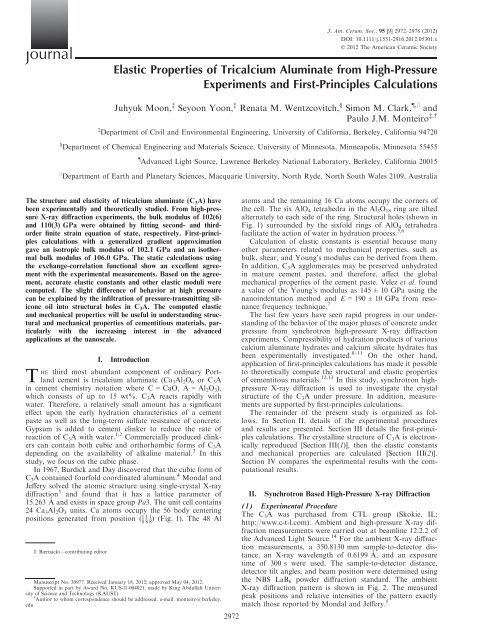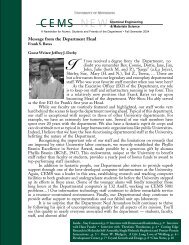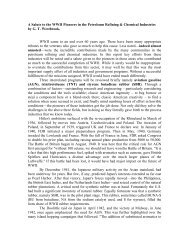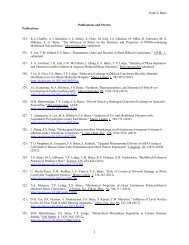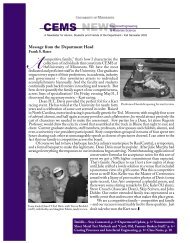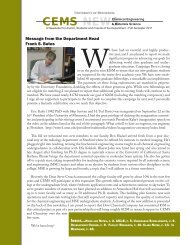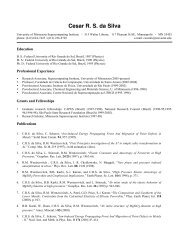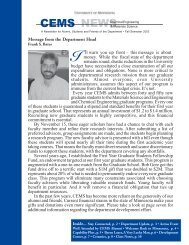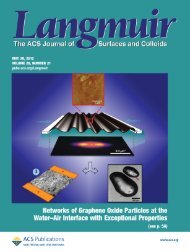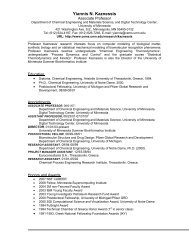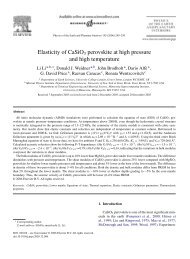Elastic Properties of Tricalcium Aluminate from High-Pressure ...
Elastic Properties of Tricalcium Aluminate from High-Pressure ...
Elastic Properties of Tricalcium Aluminate from High-Pressure ...
Create successful ePaper yourself
Turn your PDF publications into a flip-book with our unique Google optimized e-Paper software.
Journal<br />
J. Am. Ceram. Soc., 95 [9] 2972–2978 (2012)<br />
DOI: 10.1111/j.1551-2916.2012.05301.x<br />
© 2012 The American Ceramic Society<br />
<strong>Elastic</strong> <strong>Properties</strong> <strong>of</strong> <strong>Tricalcium</strong> <strong>Aluminate</strong> <strong>from</strong> <strong>High</strong>-<strong>Pressure</strong><br />
Experiments and First-Principles Calculations<br />
Juhyuk Moon, ‡ Seyoon Yoon, ‡ Renata M. Wentzcovitch, § Simon M. Clark, ,|| and<br />
Paulo J.M. Monteiro ‡,†<br />
‡ Department <strong>of</strong> Civil and Environmental Engineering, University <strong>of</strong> California, Berkeley, California 94720<br />
§ Department <strong>of</strong> Chemical Engineering and Materials Science, University <strong>of</strong> Minnesota, Minneapolis, Minnesota 55455<br />
Advanced Light Source, Lawrence Berkeley National Laboratory, Berkeley, California 20015<br />
|| Department <strong>of</strong> Earth and Planetary Sciences, Macquarie University, North Ryde, North South Wales 2109, Australia<br />
The structure and elasticity <strong>of</strong> tricalcium aluminate (C 3 A) have atoms and the remaining 16 Ca atoms occupy the corners <strong>of</strong><br />
diffraction 5 and found that it has a lattice parameter <strong>of</strong> II. Synchrotron Based <strong>High</strong>-<strong>Pressure</strong> X-ray Diffraction<br />
15.263 A˚ and exists in space group Pa3. The unit cell contains<br />
(1) Experimental Procedure<br />
24 Ca 3 Al 2 O 3 units. Ca atoms occupy the 56 body centering<br />
positions generated <strong>from</strong> position ( 1 1 1<br />
8 8 8 ) (Fig. 1). The 48 Al The C 3 A was purchased <strong>from</strong> CTL group (Skokie, IL;<br />
http://www.c-t-l.com). Ambient and high-pressure X-ray diffraction<br />
been experimentally and theoretically studied. From high-pressure<br />
X-ray diffraction experiments, the bulk modulus <strong>of</strong> 102(6)<br />
and 110(3) GPa were obtained by fitting second- and thirdorder<br />
finite strain equation <strong>of</strong> state, respectively. First-principles<br />
calculations with a generalized gradient approximation<br />
gave an isotropic bulk modulus <strong>of</strong> 102.1 GPa and an isothermal<br />
bulk modulus <strong>of</strong> 106.0 GPa. The static calculations using<br />
the exchange-correlation functional show an excellent agreement<br />
with the experimental measurements. Based on the agreement,<br />
accurate elastic constants and other elastic moduli were<br />
computed. The slight difference <strong>of</strong> behavior at high pressure<br />
can be explained by the infiltration <strong>of</strong> pressure-transmitting silicone<br />
oil into structural holes in C 3 A. The computed elastic<br />
and mechanical properties will be useful in understanding structural<br />
and mechanical properties <strong>of</strong> cementitious materials, particularly<br />
the cell. The six AlO 4 tetrahedra in the Al 3 O 18 ring are tilted<br />
alternately to each side <strong>of</strong> the ring. Structural holes (shown in<br />
Fig. 1) surrounded by the sixfold rings <strong>of</strong> AlO 4 tetrahedra<br />
facilitate the action <strong>of</strong> water in hydration process. 5,6<br />
Calculation <strong>of</strong> elastic constants is essential because many<br />
other parameters related to mechanical properties, such as<br />
bulk, shear, and Young’s modulus can be derived <strong>from</strong> them.<br />
In addition, C 3 A agglomerates may be preserved unhydrated<br />
in mature cement pastes, and therefore, affect the global<br />
mechanical properties <strong>of</strong> the cement paste. Velez et al. found<br />
a value <strong>of</strong> the Young’s modulus as 145 ± 10 GPa using the<br />
nanoindentation method and E = 190 ± 10 GPa <strong>from</strong> resonance<br />
frequency technique. 7<br />
The last few years have seen rapid progress in our understanding<br />
<strong>of</strong> the behavior <strong>of</strong> the major phases <strong>of</strong> concrete under<br />
with the increasing interest in the advanced pressure <strong>from</strong> synchrotron high-pressure X-ray diffraction<br />
applications at the nanoscale.<br />
experiments. Compressibility <strong>of</strong> hydration products <strong>of</strong> various<br />
calcium aluminate hydrates and calcium silicate hydrates has<br />
been experimentally investigated.<br />
I. Introduction<br />
On the other hand,<br />
application <strong>of</strong> first-principles calculations has made it possible<br />
THE<br />
third most abundant component <strong>of</strong> ordinary Portland<br />
cement is tricalcium aluminate (Ca 3 Al 2 O 6 or C 3 A <strong>of</strong> cementitous materials. 12,13 In this study, synchrotron high-<br />
to theoretically compute the structural and elastic properties<br />
in cement chemistry notation where C = CaO, A = Al 2 O 3 ),<br />
which consists <strong>of</strong> up to 15 wt%. C 3 A reacts rapidly with<br />
water. Therefore, a relatively small amount has a significant<br />
effect upon the early hydration characteristics <strong>of</strong> a cement<br />
paste as well as the long-term sulfate resistance <strong>of</strong> concrete.<br />
Gypsum is added to cement clinker to reduce the rate <strong>of</strong><br />
reaction <strong>of</strong> C 3 A with water. 1,2 Commercially produced clinkers<br />
can contain both cubic and orthorhombic forms <strong>of</strong> C 3 A<br />
depending on the availability <strong>of</strong> alkaline material. 3 In this<br />
study, we focus on the cubic phase.<br />
In 1967, Burdick and Day discovered that the cubic form <strong>of</strong><br />
pressure X-ray diffraction is used to investigate the crystal<br />
structure <strong>of</strong> the C 3 A under pressure. In addition, measurements<br />
are supported by first-principles calculations.<br />
The remainder <strong>of</strong> the present study is organized as follows.<br />
In Section II, details <strong>of</strong> the experimental procedures<br />
and results are presented. Section III details the first-principles<br />
calculations. The crystalline structure <strong>of</strong> C 3 A is electronically<br />
reproduced [Section III(1)], then the elastic constants<br />
and mechanical properties are calculated [Section III(2)].<br />
Section IV compares the experimental results with the computational<br />
results.<br />
C 3 A contained fourfold coordinated aluminum. 4 Mondal and<br />
Jeffery solved the atomic structure using single-crystal X-ray<br />
measurements were carried out at beamline 12.2.2 <strong>of</strong><br />
the Advanced Light Source. 14 For the ambient X-ray diffraction<br />
measurements, a 350.8130 mm sample-to-detector distance,<br />
J. Biernacki—contributing editor<br />
an X-ray wavelength <strong>of</strong> 0.6199 A˚ , and an exposure<br />
time <strong>of</strong> 300 s were used. The sample-to-detector distance,<br />
detector tilt angles, and beam position were determined using<br />
Manuscript No. 30977. Received January 18, 2012; approved May 04, 2012.<br />
the NBS LaB 6 powder diffraction standard. The ambient<br />
Supported in part by Award No. KUS-l1-004021, made by King Abdullah University<br />
X-ray diffraction pattern is shown in Fig. 2. The measured<br />
<strong>of</strong> Science and Technology (KAUST).<br />
peak positions and relative intensities <strong>of</strong> the pattern exactly<br />
Author to whom correspondence should be addressed. e-mail: monteiro@berkeley.<br />
edu<br />
match those reported by Mondal and Jeffery. 5<br />
2972
September 2012 <strong>Elastic</strong> <strong>Properties</strong> <strong>of</strong> <strong>Tricalcium</strong> <strong>Aluminate</strong> 2973<br />
GmbH, Norderstedt, Germany) was used to collected X-ray<br />
diffraction data. The Fit2D s<strong>of</strong>tware package 16 was used to<br />
convert the diffraction data <strong>from</strong> 2-D images to conventional<br />
plots <strong>of</strong> intensity versus 2h. A series <strong>of</strong> integrated X-ray diffraction<br />
patterns at a range <strong>of</strong> pressures is shown in Fig. 2.<br />
The filled circle indicates a strong diffraction peak <strong>from</strong> the<br />
ruby pressure standard.<br />
Fig. 1. (a) Optimized crystal structure <strong>of</strong> tricalcium aluminate<br />
(C 3 A) and (b) six-member ring <strong>of</strong> AlO 4 tetrahedra showed along<br />
[100] and [-1-1-1] direction, respectively. Gray polyhedra are AlO 4<br />
tetrahedra. Gray, blue, and black spheres represent Al, Ca, and O<br />
atoms, respectively.<br />
Fig. 2. Integrated powder X-ray diffraction patterns <strong>of</strong> C 3 A as a<br />
function <strong>of</strong> pressure, reported in the 2h range 6–24° (k = 0.6199 Å).<br />
The below four patterns were collected during decompression. The<br />
vertical bottom lines are Bragg peaks positions <strong>from</strong> Mondal and<br />
Jeffery. 5 The filled circle indicates diffraction peaks <strong>of</strong> ruby.<br />
<strong>High</strong> pressures were generated using a diamond anvil cell<br />
(DAC) fitted with 300 lm culet diamonds. A 125 lm thick<br />
piece <strong>of</strong> stainless steel was use to make the gasket. This was<br />
pressed between the diamonds to a thickness <strong>of</strong> 75 lm and a<br />
180 lm hole was drilled in the center to form the sample<br />
chamber. The sample was finely ground and loaded into the<br />
gasket hole together silicone oil (a mixture <strong>of</strong> polysiloxane<br />
chains with methyl and phenyl groups), which acted as the<br />
pressure-transmitting fluid and a few 2 lm ruby spheres. We<br />
waited for 20 min after each pressure increase before collecting<br />
data to allow complete equilibration <strong>of</strong> the sample and<br />
pressure-transmitting fluid.<br />
The same sample-to-detector distance (350.8130 mm) and<br />
X-ray wavelength (0.6199 A˚ ) as used for the ambient<br />
pressure measurement were also used for the high-pressure<br />
measurements. An exposure time <strong>of</strong> 600 s was found sufficient<br />
to give an adequate signal to noise ratio. Powder diffraction<br />
patterns were collected at intervals between 0.1 and<br />
4.8 GPa with both increasing and decreasing pressure. The<br />
pressure was measured using the ruby fluorescence technique.<br />
15 A MAR345 image plate detector (Marresearch<br />
(2) Experimental Results<br />
The XFit s<strong>of</strong>tware package 17 was used to determine the positions<br />
<strong>of</strong> the X-ray diffraction peaks in the diffraction patterns<br />
shown in Fig. 2 using a series <strong>of</strong> pseudo-voight peak pr<strong>of</strong>iles.<br />
Unit-cell parameters and the unit-cell volumes were determined<br />
<strong>from</strong> the peak positions using the Celref s<strong>of</strong>tware<br />
package. 18 At ambient pressure, 25 diffraction peaks were<br />
used to refine the unit-cell parameter and volume. Although<br />
some <strong>of</strong> the weak peaks <strong>of</strong> C 3 A disappeared into the background<br />
as we increased pressure, 14 peaks remained throughout<br />
the pressure range <strong>of</strong> study, which are enough to<br />
calculate an accurate unit-cell parameter and volume. The<br />
unit-cell parameters and volumes that we determined are<br />
contained in Table I. At ambient pressure with the lattice<br />
parameter a = 15.259(6) A˚ and unit-cell volume V = 3552<br />
(1) A˚ 3 that we determined agree well with a previous study<br />
by Mondal and Jeffery, which found a = 15.263(3) A˚ and<br />
V = 3556(2) A˚ 3 .<br />
The ranges <strong>of</strong> lattice parameters contained in Table I and<br />
shown in Fig. 3 are seen to increase at high pressure. This is<br />
due to a peak broadening effect in the DAC. A weighted<br />
linear least-squares fit was applied to the data to assess both<br />
pressure and volume errors. 19 The pressure normalized volume<br />
data were fitted by a second- and third- order finite strain<br />
equation <strong>of</strong> state (EoS) (i.e., Murnaghan and Birch-Murnaghan<br />
EoS, Fig. 4). 20 As the crystal structure <strong>of</strong> C 3 A is a<br />
simple cubic, the finite strain EoS is the ideal EoS for C 3 A<br />
under hydrostatic pressure. The third-order finite strain EoS is<br />
(<br />
P ¼ 3 7<br />
2 K V 3<br />
)<br />
5<br />
V 3<br />
0<br />
V 0<br />
V 0<br />
"<br />
1 þ 3 4 K0 0 4 ( )# (1)<br />
2<br />
V 3<br />
1<br />
V 0<br />
where V is volume <strong>of</strong> the unit cell, V 0 is initial volume <strong>of</strong> the<br />
unit cell at ambient pressure, P is the pressure applied to the<br />
material, K 0 is the bulk modulus at zero pressure, and K 0 0 is<br />
the derivative <strong>of</strong> the bulk modulus at zero pressure. By defining<br />
the normalized pressure, F and the Eulerian strain, f, the<br />
third finite strain EoS is reorganized into the linear form:<br />
FðfÞ ¼K 0 1:5K 0 ð4 K 0 0Þf (2)<br />
7=3 <br />
5=3<br />
V<br />
V<br />
where F ¼ P= 1:5<br />
V 0<br />
V 0<br />
2=3<br />
f ¼ 1 2<br />
1 .<br />
V<br />
V 0<br />
and<br />
In a plot <strong>of</strong> F versus f, the y-intercept and slope <strong>of</strong> graph<br />
gives the bulk modulus K 0 and its derivative K 0 0 , which we<br />
determined using a weighted linear least-squares fit. The<br />
ambient pressure volume, V 0 , used in the finite strain EoS<br />
was our ambient pressure value <strong>of</strong> 3552.6 A˚ . 21 The thirdorder<br />
finite strain EoS when fitted to our experimentally<br />
determined volumes gave a goodness <strong>of</strong> fit parameter<br />
R 2 = 0.998. We determined a bulk modulus <strong>of</strong> 110(3) GPa<br />
with a derivative <strong>of</strong> 9.5. In addition, we fitted a second-order<br />
finite strain EoS to our data and obtained a bulk modulus <strong>of</strong><br />
102(6) GPa.
2974 Journal <strong>of</strong> the American Ceramic Society—Moon et al. Vol. 95, No. 9<br />
Table I. Measured Lattice Parameters <strong>of</strong> <strong>Tricalcium</strong> <strong>Aluminate</strong> (C 3 A) at Investigated <strong>Pressure</strong>s<br />
<strong>Pressure</strong> (GPa) Ambient 0.1(1) 0.4(1) 1.2(2) 2.9(3) 3.6(3) 4.8(4) 4.1(3) 3.5(3) 2.9(3) 0.2(1)<br />
Lattice parameter, a (A˚ ) 15.259 (6) 15.258 (6) 15.256 (6) 15.202 (9) 15.135 (9) 15.11 (2) 15.06 (1) 15.09 (2) 15.12 (2) 15.14 (3) 15.27 (3)<br />
3<br />
Volume (A˚ ) 3552 (1) 3552 (1) 3551 (1) 3513 (2) 3467 (2) 3447 (3) 3415 (2) 3435 (3) 3454 (3) 3468 (5) 3559 (5)<br />
Standard deviations in parentheses.<br />
Fig. 3. Structural changes in a unit-cell parameter <strong>of</strong> C 3 A under<br />
hydrostatic pressure.<br />
Fig. 4. Normalized unit-cell volume as a function <strong>of</strong> pressure fitted<br />
to the third- and second-order finite strain Equation <strong>of</strong> State (EoS).<br />
Closed and open symbols correspond to experimental data during<br />
increasing and decreasing pressure, respectively. Blue and red lines<br />
are third- and second-order finite strain EoS fitting curves.<br />
III. First-Principles Calculations<br />
(1) Computational Details<br />
In this section, the theoretical computation is presented. The<br />
main problem in quantum mechanics is how to solve the<br />
Schro¨ dinger equation for the total wavefunction <strong>of</strong> a system.<br />
Density functional theory (DFT) has been successfully used<br />
to solve the equation for a system <strong>of</strong> interacting electrons in<br />
periodic potential sets. 22,23 During the calculation, the<br />
exchange-correlation potential is approximated as a functional<br />
<strong>of</strong> electron densities. As the exchange-correlation<br />
potential, Perdew–Burke–Ernzerh<strong>of</strong> (PBE) generalized gradient<br />
approximation (GGA) 24 incorporates a dependence on<br />
local charge density gradients <strong>from</strong> a homogeneous electron<br />
gas. In addition, the pseudopotential approximation is useful<br />
for effective computations. This substitutes the strong potential<br />
<strong>from</strong> the nucleus and core electrons for a slowly varying<br />
potential with the same scattering properties.<br />
In this study, all calculations were performed on Linux clusters<br />
in the Molecular Graphics and Computation Facility at<br />
the University <strong>of</strong> California, Berkeley. DFT calculations were<br />
performed using the PBE-GGA potential for exchange-correlation<br />
energy and plane-wave techniques as implemented in the<br />
Quantum ESPRESSO distribution. 25 Vanderbilt Ultras<strong>of</strong>t<br />
pseudopotential, 26 which is highly accurate and allows a low<br />
energy cut<strong>of</strong>f, are generated. The configurations <strong>of</strong> reference<br />
and core radii (r_c) for pseudopotentials have been taken as 3s 2<br />
3p 6 4s 2 and r_c = 1.2 A˚ for Ca, 2s 2 2p 6 3s 2 3p 1 and r_c = 1.1 A˚<br />
for Al, and 2s 2 2p 4 and r_c = 0.8 A˚ for O, respectively.
September 2012 <strong>Elastic</strong> <strong>Properties</strong> <strong>of</strong> <strong>Tricalcium</strong> <strong>Aluminate</strong> 2975<br />
Table II.<br />
Summaries <strong>of</strong> Atomic Positions <strong>of</strong> Mondal and Jeffery and Optimized C 3 A. Referred to its Symmetry <strong>of</strong> Pa3, the<br />
Coordinations <strong>of</strong> 14 Atoms are Summarized Instead <strong>of</strong> 264 Atoms<br />
Mondal and Jeffery 1975 5<br />
Pa3, a = 15.263 A˚<br />
Optimized atomic structure, this study<br />
Pa3, a = 15.39 Å<br />
x y z x y z<br />
Ca1 0 0 0 0 0 0<br />
Ca2 0.5 0 0 0.5 0 0<br />
Ca3 0.2561 (1) 0.2561 (1) 0.2561 (1) 0.2516 0.2516 0.2516<br />
Ca4 0.3750 (1) 0.3750 (1) 0.3750 (1) 0.3686 0.3688 0.3688<br />
Ca5 0.1386 (1) 0.3763 (1) 0.1272 (1) 0.1421 0.3814 0.1271<br />
Ca6 0.3800 (1) 0.3838 (1) 0.1209 (1) 0.3803 0.3764 0.1204<br />
Al1 0.2526 (1) 0.0133 (1) 0.0197 (1) 0.2517 0.0133 0.0192<br />
Al2 0.2444 (1) 0.2335 (1) 0.0046 (1) 0.2435 0.2298 0.0045<br />
O1 0.2777 (2) 0.1241 (2) 0.0103 (2) 0.2878 0.1227 0.0103<br />
O2 0.4835 (2) 0.1315 (2) 0.2536 (2) 0.4825 0.1300 0.2649<br />
O3 0.2664 (2) 0.2841 (2) 0.1049 (2) 0.2627 0.2823 0.1042<br />
O4 0.2350 (2) 0.4047 (2) 0.2921 (2) 0.2357 0.4027 0.2872<br />
O5 0.3491 (2) 0.0385 (2) 0.0174 (2) 0.3467 0.0463 0.0098<br />
O6 0.1509 (2) 0.0104 (2) 0.0242 (2) 0.1515 0.0030 0.0333<br />
Standard deviations in parentheses.<br />
Calculations <strong>of</strong> elastic properties required precisely relaxed<br />
atomic structures and highly converged total energies, forces,<br />
and stresses. For special integration points over reciprocal<br />
space, a c-point sampling (i.e., k-points grid <strong>of</strong> 1 9 1 9 1) <strong>of</strong><br />
the Brillouin zone was chosen due to the large size <strong>of</strong> the system<br />
(264 atoms in a unit cell). Before calculating structural<br />
and elastic properties, a structural optimization was performed<br />
to equilibrate the structure at arbitrary pressures.<br />
This optimization is important to avoid possible metastable<br />
states and to ensure that the relaxed structure is in the region<br />
where linear elasticity holds. Both atomic positions and<br />
lattice parameters were fully relaxed with strict convergence<br />
criteria. For the convergence criteria, a plane-wave cut<strong>of</strong>f<br />
energy <strong>of</strong> 1000 eV for the wave functions and geometry optimization<br />
convergence <strong>of</strong> 10 5 eV for the total energy were<br />
used. Although cubic symmetry was not enforced, unit-cell<br />
angles remained equal to 90° and lattice parameters remained<br />
essentially equal, indicating that a simple cubic symmetry<br />
was always found after relaxation. The achieved residual<br />
stress components were less than 1 kbar.<br />
The relaxed lattice parameter obtained using this method<br />
was found to be 15.39 A˚ , which is 0.8% larger than that<br />
experimentally obtained by us and Mondal and Jeffery. 5 This<br />
slight overestimation <strong>of</strong> the cell parameter is commonly<br />
observed when using the PBE-GGA functional form. 27,28 The<br />
fractional atomic positions <strong>of</strong> Mondal and Jeffery and the<br />
relaxed cell parameters are summarized in Table II. Due to<br />
symmetry equivalence in space group Pa3, coordinations <strong>of</strong><br />
only 14 out <strong>of</strong> the 264 atoms in the simulation are listed. The<br />
results <strong>of</strong> our calculations show an excellent agreement with<br />
the experimental data. The optimized crystal structure and<br />
six-member ring <strong>of</strong> AlO 4 tetrahedra are graphically shown in<br />
Fig. 1.<br />
(2) Computational Results<br />
The components <strong>of</strong> the elastic constant tensor were calculated<br />
using standard stress-strain relations. 29,30 The Nielsen-<br />
Martin 31 stresses were obtained <strong>from</strong> the fully relaxed<br />
structures. Starting <strong>from</strong> the relaxed system with lattice<br />
parameters ða * ; * b ; * c ÞðA * Þ, the lattice parameters <strong>of</strong> the<br />
*<br />
strained unit cell ða 0<br />
* * *<br />
; b<br />
0 ; c<br />
0 ÞðA<br />
0 Þ were obtained <strong>from</strong> the<br />
*<br />
relationship A 0 * * * *<br />
¼ðI þ e Þ A , where I is the unit matrix and<br />
*<br />
e is a Lagrangian strain tensor.<br />
Due to the cubic symmetry, C 3 A has three independent<br />
tensor coefficients: C 11 ,C 12 , and C 44 . Two different strains <strong>of</strong><br />
* *<br />
e 1 and e4 were applied 30,32 :<br />
*<br />
e1 ¼<br />
*<br />
e 4 ¼<br />
0 1<br />
d 0 0<br />
@ 0 0 0A (3)<br />
0 0 0<br />
0<br />
1<br />
0 0 0<br />
@ 0 0 d=2 A (4)<br />
0 d=2 0<br />
where the indices are given in the Voigt notation. Strains <strong>of</strong><br />
different magnitude (d = 0.5%, 1%, 1.5%, and 2%) were<br />
applied to compute the elastic constants at zero pressure.<br />
From the linear relationship between stress r i and strain ɛ j<br />
(Hooke’s law),<br />
r i ¼ X6<br />
j¼1<br />
C ij e j (5)<br />
where C ij are the elastic constants, the linear dependence <strong>of</strong><br />
the constants on strain could be formulated (Fig. 5). From<br />
Fig. 5. Computed elastic constants versus applied strains. The solid<br />
lines represent linear fits to the calculated values <strong>of</strong> stress for three<br />
elastic stiffness constants.
2976 Journal <strong>of</strong> the American Ceramic Society—Moon et al. Vol. 95, No. 9<br />
Applied strain<br />
Table III.<br />
Calculated <strong>Elastic</strong> Constants and Mechanical <strong>Properties</strong> using Voigt–Reuss–Hill Approximation (VRH)<br />
This study<br />
Manzano et al. 12<br />
0.5% 1.0% 1.5% 2.0% At zero pressure 3% to 3% in steps <strong>of</strong> 1%<br />
C11 (GPa) 168.3 168.7 167.9 165.7 169.8 172.1<br />
C12 (GPa) 68.9 69.4 69.9 70.1 68.3 68.3<br />
C44 (GPa) 53.4 53.1 53.1 52.6 53.7 56.1<br />
K (GPa) 102.0 102.5 102.6 101.9 102.1 102.9<br />
G (GPa) 51.99 (1) 51.7 (1) 51.4 (1) 50.6 (1) 52.5 (1) 54.4<br />
E (GPa) 133.1 132.7 132.2 130.3 134.4 138.7<br />
g 0.28 0.28 0.29 0.29 0.28 0.28<br />
Standard deviations in parentheses <strong>from</strong> Voigt–Reuss bound.<br />
the linear fitting <strong>of</strong> the computed points, the intercepts <strong>of</strong> the<br />
three lines give 169.8, 68.3, and 53.7 GPa for C11, C12, and<br />
C44, respectively. The calculated elastic constants are summarized<br />
in Table III.<br />
We computed bulk moduli using two different methods.<br />
The first method uses the calculated elastic constants for the<br />
Voigt–Reuss–Hill (VRH) averages. This method gives a bulk<br />
modulus (K) and bounds on the shear (G) modulus <strong>of</strong> isotropic<br />
poly-crystalline aggregates. 33,34 From the computed K<br />
and G, Young modulus (E) and Poisson ratio (g) can be also<br />
calculated (Table III). The second method is based on an<br />
analysis <strong>of</strong> the total energies <strong>of</strong> uniformly compressed<br />
states. 20,35 In this case, Eulerian strains are applied and the<br />
finite strain EoS is fit to the pressure versus volume relation.<br />
Figure 6 shows five computational data points up to 10 GPa<br />
and the fitting curve. This gives K 0 = 106.0 GPa, K 0 0 = 3.8,<br />
and V 0 = 3647.4 A˚ 3 . Manzano et al. applied first method to<br />
compute elastic constants and mechanical properties <strong>of</strong> C 3 A<br />
(see Table III). In this study, we applied both methods to<br />
compare the results with the high-pressure experiment.<br />
IV. Discussion<br />
<strong>High</strong>-pressure X-ray diffraction has the unique ability to<br />
directly observe the structure <strong>of</strong> a crystal under pressure,<br />
making it possible to obtain the bulk modulus and its<br />
pressure derivative. However, because <strong>of</strong> the extremely small<br />
amount <strong>of</strong> sample in a DAC, the diffraction resolution might<br />
not be sufficient to refine the structure, especially for a complex<br />
structure at high pressures. In addition, the pressure<br />
behavior in the DAC depends on the type <strong>of</strong> pressure-transmitting<br />
medium and various pressure-induced reactions. 10,36<br />
Therefore, it is desirable that high-pressure experimental data<br />
should be verified by atomic-level simulations. On the other<br />
hand, all atomic-scale computations should be confirmed by<br />
experiments. Thus, high-pressure X-ray diffraction technique<br />
and first-principle calculations are excellent complementary<br />
methods to each other.<br />
Two interesting observations in the experimental results<br />
are worth noting. The first is the large K 0 0 value given by the<br />
third finite strain EoS, which indicates that a significant second-order<br />
effect in K 0 is not negligible. Figure 4 shows the<br />
difference between second- and third-order finite strain EoS<br />
fitting at higher pressure. The second observation <strong>of</strong> note is<br />
that the volumes after unloading are slightly expanded compared<br />
with those obtained during the loading process. (Fig. 4<br />
and sub plot in Fig. 7). This may be explained by the infiltration<br />
<strong>of</strong> silicone oil into the crystal structure <strong>of</strong> the C 3 A sample.<br />
There are 80 cavities in the structure <strong>of</strong> C 3 A (Fig. 1).<br />
Seventy-two <strong>of</strong> these are filled with Ca atoms and the<br />
remaining eight cavities are surrounded by sixfold rings <strong>of</strong><br />
AlO 4 tetrahedra. 5 If molecules <strong>of</strong> the pressure-transmitting<br />
medium are small enough to enter the cavities then the volume<br />
compressibility would become lower than that measured<br />
with a non-penetrating fluid. 10,11 Therefore, as the structural<br />
cavities fill with silicone oil, the structure becomes stiffer,<br />
K 0 = 106.0 GPa and K0 = 3.8. over 3 GPa.<br />
Fig. 7. Experimental and computational normalized volumes versus<br />
Fig. 6. Calculated structural changes under pressure. The circles<br />
pressures. Closed and open symbols represent the experimental data<br />
during increasing and decreasing pressure, respectively. The red<br />
circles represent ab initio computation data points. The black and<br />
red lines correspond to third finite strain EoS curves fitted to the<br />
represent our ab initio computation results. The red line corresponds experimental and computational data, respectively. Due to the<br />
to third-order finite strain Equation <strong>of</strong> State fitting, which yields<br />
smaller pressure derivative in computation, there is a slight difference
September 2012 <strong>Elastic</strong> <strong>Properties</strong> <strong>of</strong> <strong>Tricalcium</strong> <strong>Aluminate</strong> 2977<br />
Table IV.<br />
Comparison <strong>of</strong> the Results <strong>of</strong> the <strong>High</strong>-<strong>Pressure</strong> Experiments and Ab Initio Calculations. To Compute the Bulk<br />
Modulus and its Derivative, Second- and Third-order Finite Strain Equation <strong>of</strong> State (EoS) were Used<br />
Lattice parameter, a (A˚ ) Volume (A˚ 3 ) K 0 0 K 0 (GPa)<br />
<strong>High</strong> pressure experiment (this study) Third finite strain EoS 15.254(6) 3549(1) 9.5 102(6)<br />
Second finite strain EoS 15.254(6) 3549(1) 4 110(3)<br />
Ab initio calculations (this study) VRH approximation 15.39 3645.2 n.d 102.1<br />
Third finite strain EoS 15.39 3647.4 3.8 106.0<br />
Ab initio calculations (Manzano et al. 12 ) VRH approximation 15.38 3638.1 n.d 102.9<br />
n.d: not determined<br />
which gives a larger K 0 0 . The infiltration <strong>of</strong> silicone oil can<br />
also explain the unexpected volume expansion during<br />
unloading.<br />
It was not possible to include this effect in our simulations.<br />
In theoretical calculations, the stiffness <strong>of</strong> the atomistic<br />
framework itself is <strong>of</strong> concern. First, the atomic structure <strong>of</strong><br />
C 3 A was reproduced by full relaxation <strong>of</strong> the structural<br />
parameters using damped variable cell shape molecular<br />
dynamics. 25 This allows lattice parameters and atomic positions<br />
to move until both the energy and force convergence<br />
criteria are satisfied. Then, elastic constants were computed.<br />
This stress-strain approach determined elastic constants for<br />
which isothermal and adiabatic values are identical by calculating<br />
forces for strained configurations. Next, the VRH<br />
approximation was applied to compute the average bulk<br />
modulus <strong>of</strong> an isotropic poly-crystalline aggregate. Consistent<br />
results were obtained for the relaxed structure and<br />
elastic constants determined by Manzano et al. (Table III)<br />
within the 3% error range.<br />
In our experiment, the isothermal bulk modulus was determined<br />
<strong>from</strong> the EoS parameters. Calculations were performed<br />
to simulate isotropic experimental conditions and<br />
direct comparison between experimental and computational<br />
pressure versus volume is possible as summarized in<br />
Table IV and Fig. 7. A slightly larger value <strong>of</strong> K 0 , 106 GPa,<br />
is obtained by fitting the finite strain EoS, than the VRH<br />
average <strong>of</strong> K 0 , 102 GPa. This difference is expected, as VRH<br />
averages correspond to the averaged bulk modulus <strong>of</strong> polycrystalline<br />
aggregates. However, the level <strong>of</strong> agreement <strong>of</strong><br />
isothermal bulk modulus between theory and experiments is<br />
precisely what is expected <strong>from</strong> GGA-PBE calculations: larger<br />
equilibrium volumes and smaller bulk modulus when<br />
compared with experiments. 27,28<br />
The overall pressure behavior and isothermal bulk modulus<br />
are in excellent agreement with the DFT calculation. As<br />
the experimental isothermal bulk modulus agreed well with<br />
the theoretical bulk modulus, the computed elastic tensor<br />
coefficients for C 3 A are also reliable. These elastic coefficients<br />
and the isothermal bulk modulus are fundamental material<br />
properties and knowing them will allow us to better understand<br />
the characteristics <strong>of</strong> clinker materials. In Portland<br />
cement clinker, various cations can be substituted in the large<br />
interstitial cavities in C 3 A. The experimental and computational<br />
consistence reported here gives great credibility to the<br />
computational approach to understanding the effects <strong>of</strong><br />
impurities on clinker materials. 37<br />
Acknowledgments<br />
The Advanced Light Source is supported by the Director, Office <strong>of</strong> Science,<br />
Office <strong>of</strong> Basic Energy Sciences, <strong>of</strong> the U.S. Department <strong>of</strong> Energy under Contract<br />
No. DE-AC02-05CH11231. RMW was supported by NSF/EAR<br />
1047629. The UC Berkeley Molecular Graphics and Computation Facility is<br />
supported by NSF/CHE-0840505.<br />
References<br />
1 P. K. Mehta and P. J. M. Monteiro, Concrete: Microstructure, <strong>Properties</strong><br />
and Materials, 3rd edition. eMcGraw-Hill Companies, New York, NY,<br />
2006.<br />
2 H. F. W. Taylor, Cement Chemistry, 2nd edition. Thomas Telford,<br />
London, 1997.<br />
3 I. Maki, “Nature <strong>of</strong> the Prismatic Dark Interstitial Material in Portland<br />
Cement Clinker,” Cem. Concr. Res., 3 [3] 295–313 (1973).<br />
4 V. L. Burdick and D. E. Day, “Coordination <strong>of</strong> Aluminum Ions in <strong>Tricalcium</strong><br />
<strong>Aluminate</strong>,” J. Am. Ceram. Soc., 50 [2] 97–101 (1967).<br />
5 P. Mondal and W. Jeffery, “The Crystal Structure <strong>of</strong> <strong>Tricalcium</strong> <strong>Aluminate</strong>,<br />
Ca 3 Al 2 O 6 ,” Acta Crystallogr., 31, 689–97 (1975).<br />
6 M. Collepardi, G. Baldini, and M. Pauri, “<strong>Tricalcium</strong> <strong>Aluminate</strong> Hydration<br />
in the Presence <strong>of</strong> Lime, Gypsum or Sodium sulfate,” Cem. Concr. Res.,<br />
8 [5] 571–80 (1978).<br />
7 K. Velez, S. Maximilien, D. Damidot, G. Fantozzi, and F. Sorrentino,<br />
“Determination by Nanoindentation <strong>of</strong> <strong>Elastic</strong> Modulus and Hardness <strong>of</strong> Pure<br />
Constituents <strong>of</strong> Portland Cement Clinker,” Cem. Concr. Res., 31 [4] 555–61<br />
(2001).<br />
8 S. M. Clark, B. Colas, M. Kunz, S. Speziale, and P. J. M. Monteiro,<br />
“Effect <strong>of</strong> <strong>Pressure</strong> on the Crystal Structure <strong>of</strong> Ettringite,” Cem. Concr. Res.,<br />
38 [1] 19–26 (2008).<br />
9 J. Oh, S. M. Clark, and P. J. M. Monteiro, “Does the Al substitution in C-S-<br />
H(I) change its mechanical property?” Cem. Concr. Res., 41 [1] 102–6 (2011).<br />
10 J. Moon, J. Oh, M. Balonis, F. P. Glasser, S. M. Clark, and P. J. M.<br />
Monteiro, “<strong>Pressure</strong> Induced Reactions Amongst Calcium <strong>Aluminate</strong> Hydrate<br />
Phases,” Cem. Concr. Res., 41 [6] 571–8 (2011).<br />
11 J. Moon, J. Oh, M. Balonis, F. P. Glasser, S. M. Clark, and P. J. M.<br />
Monteiro, “<strong>High</strong> <strong>Pressure</strong> Study <strong>of</strong> Low Compressibility Tetracalcium Aluminum<br />
Carbonate Hydrates 3CaO·Al 2 O 3·CaCO 3·11H 2 O,” Cem. Concr. Res.,<br />
42 [1] 105–10 (2012).<br />
12 H. Manzano, J. S. Dolado, and A. Ayuela, “Structural, Mechanical, and<br />
Reactivity <strong>Properties</strong> <strong>of</strong> <strong>Tricalcium</strong> <strong>Aluminate</strong> using First-Principles Calculations,”<br />
J. Am. Ceram. Soc., 92 [4] 897–902 (2009).<br />
13 R. Shahsavari, R. J. M. Pellenq, and F. Ulm, “First-Principles Study <strong>of</strong> <strong>Elastic</strong><br />
Constants and Interlayer Interactions <strong>of</strong> Complex Hydrated Oxides: Case Study <strong>of</strong><br />
Tobermorite and Jennite,” J. Am. Ceram. Soc., 92 [10] 2323–30 (2009).<br />
14 M. Kunz, A. A. MacDowell, W. A. Caldwell, D. Cambie, R. S. Celestre,<br />
E. E. Domning, R. M. Duarte, A. E. Gleason, J. M. Glossinger, N. Kelez, D.<br />
W. Plate, T. Yu, J. M. Zaug, H. A. Padmore, R. Jeanloz, A. P. Alivisatos,<br />
and S. M. Clark, “A beamline for <strong>High</strong>-<strong>Pressure</strong> Studies at the Advanced<br />
Light Source with a Superconducting Bending Magnet as the Source,” J. Synchrotron<br />
Radiat., 12 [5] 650–8 (2005).<br />
15 H. K. Mao, J. Xu, and P. M. Bell, “Calibration <strong>of</strong> the Ruby <strong>Pressure</strong><br />
Gauge to 800 kbar Under Quasi-Hydrostatic Conditions,” J. Geophys. Res.,<br />
91 [5] 4673–6 (1986).<br />
16 A. P. Hammersley, S. O. Svensson, M. Hanfland, A. N. Fitch, and D.<br />
Hcousermann, “Two-Dimensional Detector S<strong>of</strong>tware: From Real Detector to<br />
Idealised Image or Two-Theta Scan,” <strong>High</strong> <strong>Pressure</strong> Res., 14, 235–48 (1996).<br />
17 R. W. Cheary and A. A. Coelho, Programs XFIT and FOURYA, deposited<br />
in CCP14 Powder Diffraction Library. Engineering and Physical Sciences<br />
Research Council, Daresbury Laboratory, Warrington, England, 1996.<br />
18 J. Laugier and B. Bochu, CELREF. Version 3. Cell Parameter Refinement Program<br />
<strong>from</strong> Powder Diffraction Diagram. Laboratoire des Matériaux et du Ge´ nie Physique,<br />
Ecole Nationale Supe´ rieure de Physique de Grenoble (INPG), France, 2002.<br />
19 B. C. Reed, “Linear Least-Squares Fits with Errors in Both Coordinates,”<br />
Am. J. Phys., 57 [7] 642–6 (1989).<br />
20 F. Birch, “Finite Strain Isotherm and Velocities for Single-Crystal and<br />
Polycrystalline NaCl at <strong>High</strong> <strong>Pressure</strong>s and 300 K,” J. Geophys. Res., 83 [B3]<br />
1257–68 (1978).<br />
21 R. Jeanloz, “Finite-Strain Equation <strong>of</strong> State for <strong>High</strong>-<strong>Pressure</strong> Phases,”<br />
Geophys. Res. Lett., 8 [12] 1219–22 (1981).<br />
22 P. Hohenberg and W. Kohn, “Inhomogeneous Electron Gas,” Phys. Rev.,<br />
136 [3B] B864–71 (1964).<br />
23 W. Kohn and L. J. Sham, “Self-Consistent Equations Including Exchange<br />
and Correlation Effects,” Phys. Rev., 140 [4A] A1133–8 (1965).<br />
24 J. P. Perdew, K. Burke, and M. Ernzerh<strong>of</strong>, “Generalized Gradient<br />
Approximation Made Simple,” Phys. Rev. Lett., 77 [18] 386–8 (1996).<br />
25 P. Giannozzi, S. Baroni, N. Bonini, M. Calandra, R. Car, C. Cavazzoni,<br />
D. Ceresoli, G. L. Chiarotti, M. Cococcioni, I. Dabo, A. D. Corso, S. de<br />
Gironcoli, S. Fabris, G. Fratesi, R. Gebauer, U. Gerstmann, C. Gougoussis,<br />
A. Kokalj, M. Lazzeri, L. Martin-Samos, N. Marzari, F. Mauri, R. Mazzarello,<br />
S. Paolini, A. Pasquarello, L. Paulatto, C. Sbraccia, S. Scandolo, G.<br />
Sclauzero, A. P. Seitsonen, A. Smogunov, P. Umari, and R.M. Wentzcovitch,<br />
“QUANTUM ESPRESSO: A Modular and Open-Source S<strong>of</strong>tware Project for<br />
Quantum Simulations <strong>of</strong> Materials,” J. Phys. Condens. Matter, 21 [39] 395502,<br />
19pp (2009).
2978 Journal <strong>of</strong> the American Ceramic Society—Moon et al. Vol. 95, No. 9<br />
26 D. Vanderbilt, “S<strong>of</strong>t Self-Consistent Pseudopotentials in a Generalized<br />
Eigenvalue Formalism,” Phys. Rev. B, 41 [11] 7892–5 (1990).<br />
27 H. Yao, L. Ouyang, and W. Y. Ching, “Ab Initio Calculation <strong>of</strong> <strong>Elastic</strong><br />
Constants <strong>of</strong> Ceramic Crystals,” J. Am. Ceram. Soc., 90 [10] 3194–204<br />
(2007).<br />
28 Th. Demuth, Y. Jeanvoine, J. Hafner, and J. G. Angyan, “Polymorphism<br />
in Silica Studied in the Local Density and Generalized-Gradient Approximations,”<br />
J. Phys. Condens. Matter, 11 [19] 3833–74 (1999).<br />
29 R. M. Wentzcovitch, N. L. Ross, and G. D. Price, “Ab Initio Study <strong>of</strong><br />
MgSiO 3 and CaSiO 3 Perovskites at Lower Mantle <strong>Pressure</strong>s,” Phys. Earth Planet.<br />
Int., 90 [101] 101–12 (1995).<br />
30 B. B. Karki, L. Stixrude, and R. M. Wentzcovitch, “<strong>High</strong>-<strong>Pressure</strong> <strong>Elastic</strong><br />
<strong>Properties</strong> <strong>of</strong> Major Materials <strong>of</strong> Earth’s Mantle From First Principles,” Rev.<br />
Geophys., 39 [4] 507–34 (2001).<br />
31 O. H. Nielsen and R. M. Martin, “First-Principles Calculation <strong>of</strong> Stress,”<br />
Phys. Rev. Lett., 50 [9] 697–700 (1983).<br />
32 B. B. Karki, G. J. Ackland, and J. Crain, “<strong>Elastic</strong> Instabilities in Crystals<br />
<strong>from</strong> Ab Initio Stress-Strain Relations,” J. Phys. Condens. Matter, 9 [41] 8579–89<br />
(1997).<br />
33 R. Hill, “The <strong>Elastic</strong> Behaviour <strong>of</strong> a Crystalline Aggregate,” Proc. Phys.<br />
Soc. Sect. A, 65 [5] 349–54 (1952).<br />
34 J. P. Watt, G. F. Davies, R. J. O’Connell, and R. J, “The <strong>Elastic</strong> <strong>Properties</strong><br />
<strong>of</strong> Composite Materials,” Rev. Geophys., 14 541–63 (1976).<br />
35 J. P. Poirier, Introduction <strong>of</strong> the Physics <strong>of</strong> Earth Interior, Vol. 83, 2nd edition.<br />
Cambridge University Press, Cambridge, UK, 2000.<br />
36 M. Colligan, P. M. Forster, A. K. Cheetham, Y. Lee, T. Vogt, and J. A.<br />
Hriljac, “Synchrotron X-ray Powder Diffraction and Computational Investigation<br />
<strong>of</strong> Purely Siliceous Zeolite Y under <strong>Pressure</strong>,” J. Am. Chem. Soc., 126<br />
[38] 12015–22 (2004).<br />
37 H. Manzano, E. Durgun, M. J. A. Qomi, F. J. Ulm, R. J. M. Pellenq,<br />
and J. C. Grossman, “Impact <strong>of</strong> Chemical Impurities on the Crystalline<br />
Cement Clinker Phases Degermined by Atomistic Simulation.,” Cryst. Growth<br />
Des., 11 [7] 2964–72 (2011).<br />
h


